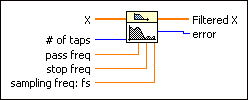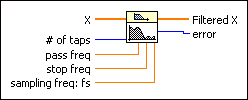Equi-Ripple LowPass VI
Owning Palette: Filters VIs
Requires: Full Development System
Generates a lowpass FIR filter with equi-ripple characteristics using the Parks-McClellan algorithm and the # of taps, pass freq, stop freq, and sampling freq: fs. The Equi-Ripple LowPass VI then applies a linear-phase, lowpass filter to the input sequence X using the Convolution VI to obtain Filtered X. Wire data to the X input to determine the polymorphic instance to use or manually select the instance.
Use the pull-down menu to select an instance of this VI.
 Add to the block diagram Add to the block diagram |
 Find on the palette Find on the palette |









